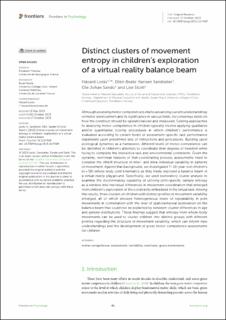| dc.contributor.author | Lorås, Håvard Wuttudal | |
| dc.contributor.author | Sandseter, Ellen Beate Hansen | |
| dc.contributor.author | Sando, Ole Johan | |
| dc.contributor.author | Storli, Lise | |
| dc.coverage.spatial | Norway | en_US |
| dc.date.accessioned | 2023-11-17T09:55:19Z | |
| dc.date.available | 2023-11-17T09:55:19Z | |
| dc.date.created | 2023-10-20T09:57:02Z | |
| dc.date.issued | 2023-10 | |
| dc.identifier.citation | Frontiers in Psychology. 2023, 1-12. | en_US |
| dc.identifier.issn | 1664-1078 | |
| dc.identifier.uri | https://hdl.handle.net/11250/3103158 | |
| dc.description.abstract | Although assessing motor competence is vital to advancing current understandings of motor development and its significance in various fields, no consensus exists on how the construct should be operationalised and measured. Existing approaches to assessing motor competence in children typically involve applying qualitative and/or quantitative scoring procedures in which children’s performance is evaluated according to certain levels of assessment-specific task performance dependent upon predefined sets of instructions and procedures. Building upon ecological dynamics as a framework, different levels of motor competence can be identified in children’s attempts to coordinate their degrees of freedom while trying to complete the interactive task and environmental constraints. Given the dynamic, nonlinear features of that coordinating process, assessments need to consider the inherit structure of inter- and intra-individual variability in patterns of movement. Against that background, we investigated 7–10-year-old children’s (n = 58) whole-body joint kinematics as they freely explored a balance beam in a virtual reality playground. Specifically, we used exploratory cluster analysis to examine the discriminatory capability of utilising joint-specific sample entropy as a window into individual differences in movement coordination that emerged from children’s exploration of the constraints embedded in the virtual task. Among the results, three clusters of children with distinct profiles of movement variability emerged, all of which showed heterogeneous levels of repeatability in joint movements in combination with the level of spatiotemporal exploration on the balance beam that could not be explained by between-cluster differences in age and gender distributions. Those findings suggest that entropy from whole-body movements can be used to cluster children into distinct groups with different profiles regarding the structure of movement variability, which can inform new understandings and the development of gross motor competence assessments for children | en_US |
| dc.description.abstract | Distinct clusters of movement entropy in children’s exploration of a virtual reality balance beam | en_US |
| dc.language.iso | eng | en_US |
| dc.publisher | Frontiers Media | en_US |
| dc.rights | Navngivelse 4.0 Internasjonal | * |
| dc.rights.uri | http://creativecommons.org/licenses/by/4.0/deed.no | * |
| dc.subject | Motor competence; | en_US |
| dc.subject | assessment; | en_US |
| dc.subject | variability; | en_US |
| dc.subject | nonlinear; | en_US |
| dc.subject | gross movements. | en_US |
| dc.title | Distinct clusters of movement entropy in children’s exploration of a virtual reality balance beam | en_US |
| dc.title.alternative | Distinct clusters of movement entropy in children’s exploration of a virtual reality balance beam | en_US |
| dc.type | Peer reviewed | en_US |
| dc.type | Journal article | en_US |
| dc.description.version | publishedVersion | en_US |
| dc.rights.holder | ©2023 Authors | en_US |
| dc.subject.nsi | VDP::Samfunnsvitenskap: 200::Psykologi: 260 | en_US |
| dc.source.pagenumber | 1-12. | en_US |
| dc.source.journal | Frontiers in Psychology | en_US |
| dc.identifier.doi | 10.3389/fpsyg.2023.1227469 | |
| dc.identifier.cristin | 2186644 | |
| cristin.ispublished | true | |
| cristin.fulltext | original | |
| cristin.qualitycode | 1 | |

